lock LINCOLN NAVIGATOR 2016 Owners Manual
[x] Cancel search | Manufacturer: LINCOLN, Model Year: 2016, Model line: NAVIGATOR, Model: LINCOLN NAVIGATOR 2016Pages: 419, PDF Size: 3.59 MB
Page 4 of 419
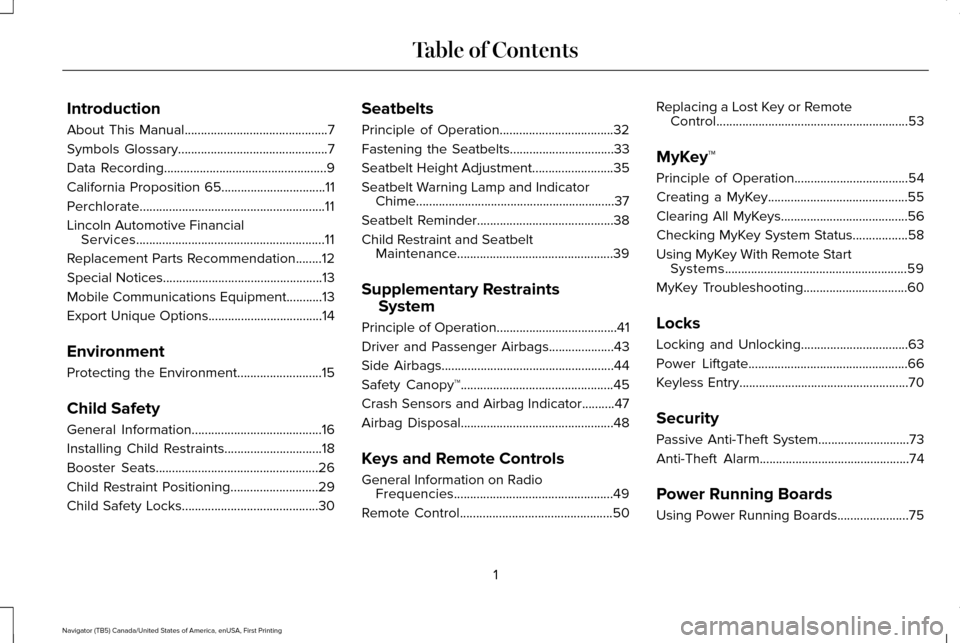
Introduction
About This Manual............................................7
Symbols Glossary
..............................................7
Data Recording
..................................................9
California Proposition 65................................11
Perchlorate.........................................................11
Lincoln Automotive Financial Services..........................................................11
Replacement Parts Recommendation........12
Special Notices
.................................................13
Mobile Communications Equipment...........13
Export Unique Options...................................14
Environment
Protecting the Environment
..........................15
Child Safety
General Information........................................16
Installing Child Restraints
..............................18
Booster Seats
..................................................26
Child Restraint Positioning
...........................29
Child Safety Locks..........................................30 Seatbelts
Principle of Operation...................................32
Fastening the Seatbelts
................................33
Seatbelt Height Adjustment.........................35
Seatbelt Warning Lamp and Indicator Chime.............................................................37
Seatbelt Reminder
..........................................38
Child Restraint and Seatbelt Maintenance................................................39
Supplementary Restraints System
Principle of Operation
.....................................41
Driver and Passenger Airbags....................43
Side Airbags
.....................................................44
Safety Canopy™...............................................45
Crash Sensors and Airbag Indicator..........47
Airbag Disposal...............................................48
Keys and Remote Controls
General Information on Radio Frequencies.................................................49
Remote Control
...............................................50 Replacing a Lost Key or Remote
Control...........................................................53
MyKey™
Principle of Operation...................................54
Creating a MyKey...........................................55
Clearing All MyKeys.......................................56
Checking MyKey System Status.................58
Using MyKey With Remote Start Systems........................................................59
MyKey Troubleshooting................................60
Locks
Locking and Unlocking
.................................63
Power Liftgate
.................................................66
Keyless Entry
....................................................70
Security
Passive Anti-Theft System............................73
Anti-Theft Alarm..............................................74
Power Running Boards
Using Power Running Boards
......................75
1
Navigator (TB5) Canada/United States of America, enUSA, First Printing Table of Contents
Page 6 of 419
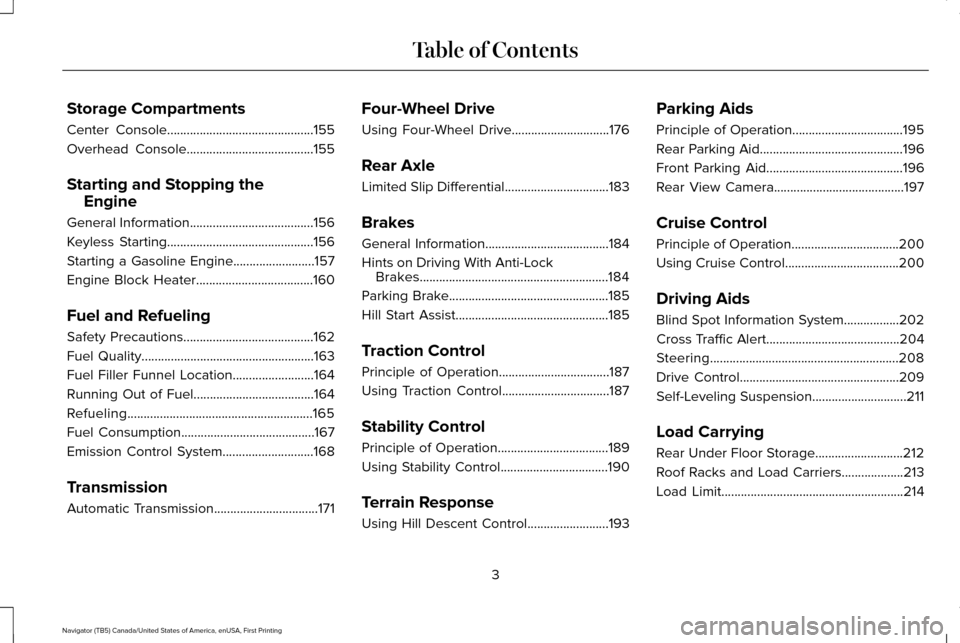
Storage Compartments
Center Console.............................................155
Overhead Console.......................................155
Starting and Stopping the Engine
General Information
......................................156
Keyless Starting.............................................156
Starting a Gasoline Engine.........................157
Engine Block Heater....................................160
Fuel and Refueling
Safety Precautions
........................................162
Fuel Quality
.....................................................163
Fuel Filler Funnel Location.........................164
Running Out of Fuel
.....................................164
Refueling.........................................................165
Fuel Consumption
.........................................167
Emission Control System
............................168
Transmission
Automatic Transmission................................171 Four-Wheel Drive
Using Four-Wheel Drive..............................176
Rear Axle
Limited Slip Differential
................................183
Brakes
General Information
......................................184
Hints on Driving With Anti-Lock Brakes
..........................................................184
Parking Brake.................................................185
Hill Start Assist...............................................185
Traction Control
Principle of Operation..................................187
Using Traction Control
.................................187
Stability Control
Principle of Operation..................................189
Using Stability Control.................................190
Terrain Response
Using Hill Descent Control.........................193 Parking Aids
Principle of Operation..................................195
Rear Parking Aid............................................196
Front Parking Aid..........................................196
Rear View Camera
........................................197
Cruise Control
Principle of Operation.................................200
Using Cruise Control...................................200
Driving Aids
Blind Spot Information System.................202
Cross Traffic Alert.........................................204
Steering..........................................................208
Drive Control.................................................209
Self-Leveling Suspension.............................211
Load Carrying
Rear Under Floor Storage...........................212
Roof Racks and Load Carriers...................213
Load Limit
........................................................214
3
Navigator (TB5) Canada/United States of America, enUSA, First Printing Table of Contents
Page 11 of 419
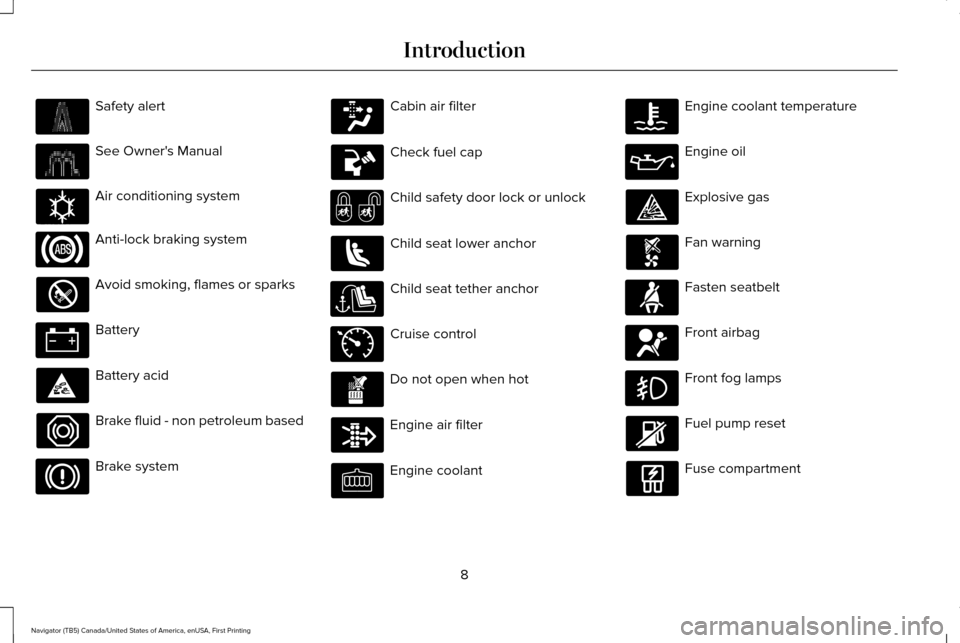
Safety alert
See Owner's Manual
Air conditioning system
Anti-lock braking system
Avoid smoking, flames or sparks
Battery
Battery acid
Brake fluid - non petroleum based
Brake system Cabin air filter
Check fuel cap
Child safety door lock or unlock
Child seat lower anchor
Child seat tether anchor
Cruise control
Do not open when hot
Engine air filter
Engine coolant Engine coolant temperature
Engine oil
Explosive gas
Fan warning
Fasten seatbelt
Front airbag
Front fog lamps
Fuel pump reset
Fuse compartment
8
Navigator (TB5) Canada/United States of America, enUSA, First Printing Introduction E162384 E71340
Page 12 of 419
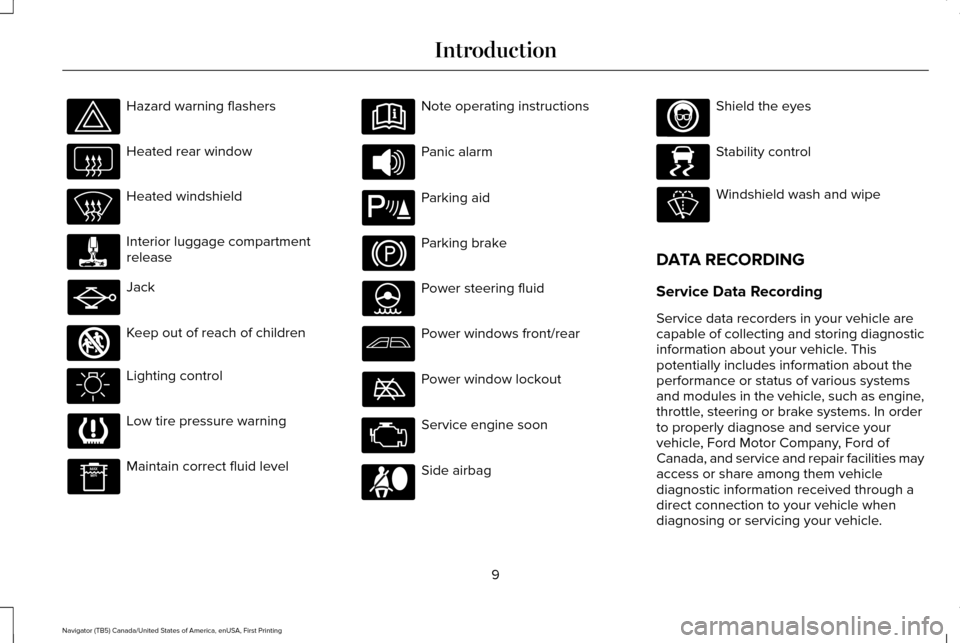
Hazard warning flashers
Heated rear window
Heated windshield
Interior luggage compartment
release
Jack
Keep out of reach of children
Lighting control
Low tire pressure warning
Maintain correct fluid level Note operating instructions
Panic alarm
Parking aid
Parking brake
Power steering fluid
Power windows front/rear
Power window lockout
Service engine soon
Side airbag Shield the eyes
Stability control
Windshield wash and wipe
DATA RECORDING
Service Data Recording
Service data recorders in your vehicle are
capable of collecting and storing diagnostic
information about your vehicle. This
potentially includes information about the
performance or status of various systems
and modules in the vehicle, such as engine,
throttle, steering or brake systems. In order
to properly diagnose and service your
vehicle, Ford Motor Company, Ford of
Canada, and service and repair facilities may
access or share among them vehicle
diagnostic information received through a
direct connection to your vehicle when
diagnosing or servicing your vehicle.
9
Navigator (TB5) Canada/United States of America, enUSA, First Printing Introduction E161353 E139213 E167012 E138639
Page 21 of 419

•
You are required by law to properly use
safety seats for infants and toddlers in
the United States and Canada.
• Many states and provinces require that
small children use approved booster
seats until they reach age eight, a height
of 4 feet 9 inches (1.45 meters) tall, or 80
pounds (36 kilograms). Check your local
and state or provincial laws for specific
requirements about the safety of children
in your vehicle.
• When possible, always properly restrain
children 12 years of age and under in a
rear seating position of your vehicle.
Accident statistics suggest that children
are safer when properly restrained in the
rear seating positions than in a front
seating position. INSTALLING CHILD RESTRAINTS
Child Seats
Use a child safety seat (sometimes called an
infant carrier, convertible seat, or toddler
seat) for infants, toddlers, or children
weighing 40 pounds (18 kilograms) or less
(generally age four or younger).Using Lap and Shoulder Belts WARNINGS
Airbags can kill or injure a child in a
child seat. Never place a rear-facing
child seat in front of an active airbag. If you
must use a forward-facing child seat in the
front seat, move the vehicle seat upon which
the seat is installed all the way back. Airbags can kill or injure a child in a
child seat. Children 12 and under
should be properly restrained in the rear seat
whenever possible. Depending on where you secure a
child restraint, and depending on the
child restraint design, you may block access
to certain safety belt buckle assemblies and
LATCH lower anchors, rendering those
features potentially unusable. To avoid risk
of injury, occupants should only use seating
positions where they are able to be properly
restrained. 18
Navigator (TB5) Canada/United States of America, enUSA, First Printing Child SafetyE142594
Page 22 of 419
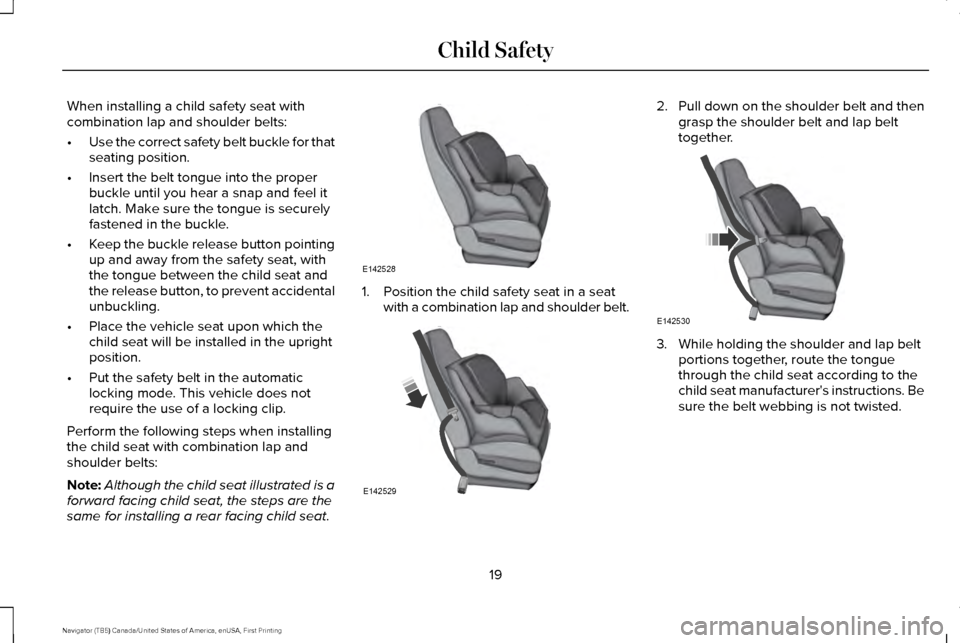
When installing a child safety seat with
combination lap and shoulder belts:
•
Use the correct safety belt buckle for that
seating position.
• Insert the belt tongue into the proper
buckle until you hear a snap and feel it
latch. Make sure the tongue is securely
fastened in the buckle.
• Keep the buckle release button pointing
up and away from the safety seat, with
the tongue between the child seat and
the release button, to prevent accidental
unbuckling.
• Place the vehicle seat upon which the
child seat will be installed in the upright
position.
• Put the safety belt in the automatic
locking mode. This vehicle does not
require the use of a locking clip.
Perform the following steps when installing
the child seat with combination lap and
shoulder belts:
Note: Although the child seat illustrated is a
forward facing child seat, the steps are the
same for installing a rear facing child seat. 1. Position the child safety seat in a seat
with a combination lap and shoulder belt. 2.
Pull down on the shoulder belt and then
grasp the shoulder belt and lap belt
together. 3. While holding the shoulder and lap belt
portions together, route the tongue
through the child seat according to the
child seat manufacturer's instructions. Be
sure the belt webbing is not twisted.
19
Navigator (TB5) Canada/United States of America, enUSA, First Printing Child SafetyE142528 E142529 E142530
Page 23 of 419
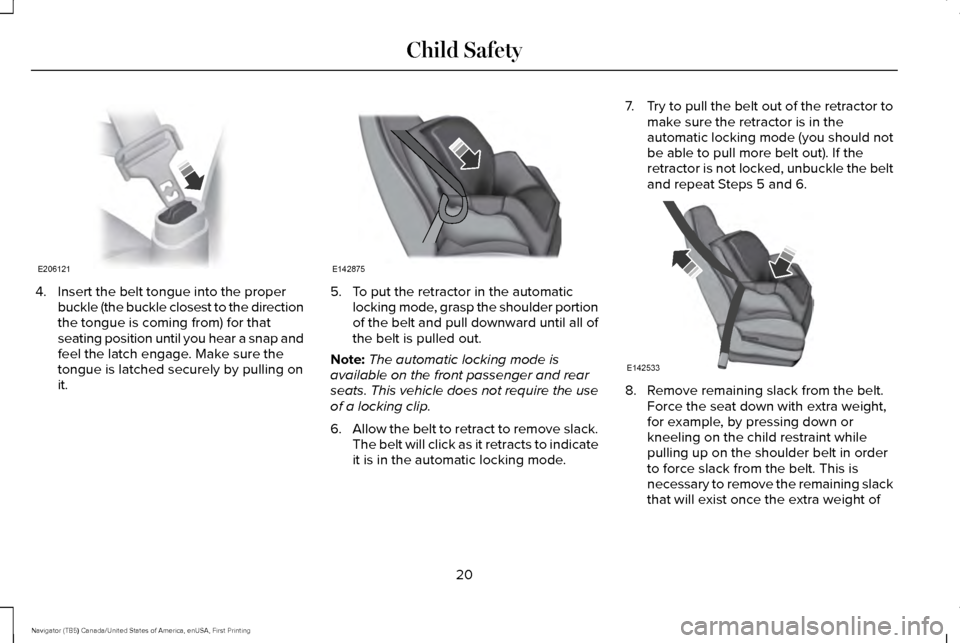
4. Insert the belt tongue into the proper
buckle (the buckle closest to the direction
the tongue is coming from) for that
seating position until you hear a snap and
feel the latch engage. Make sure the
tongue is latched securely by pulling on
it. 5. To put the retractor in the automatic
locking mode, grasp the shoulder portion
of the belt and pull downward until all of
the belt is pulled out.
Note: The automatic locking mode is
available on the front passenger and rear
seats. This vehicle does not require the use
of a locking clip.
6. Allow the belt to retract to remove slack.
The belt will click as it retracts to indicate
it is in the automatic locking mode. 7.
Try to pull the belt out of the retractor to
make sure the retractor is in the
automatic locking mode (you should not
be able to pull more belt out). If the
retractor is not locked, unbuckle the belt
and repeat Steps 5 and 6. 8. Remove remaining slack from the belt.
Force the seat down with extra weight,
for example, by pressing down or
kneeling on the child restraint while
pulling up on the shoulder belt in order
to force slack from the belt. This is
necessary to remove the remaining slack
that will exist once the extra weight of
20
Navigator (TB5) Canada/United States of America, enUSA, First Printing Child SafetyE206121 E142875 E142533
Page 33 of 419
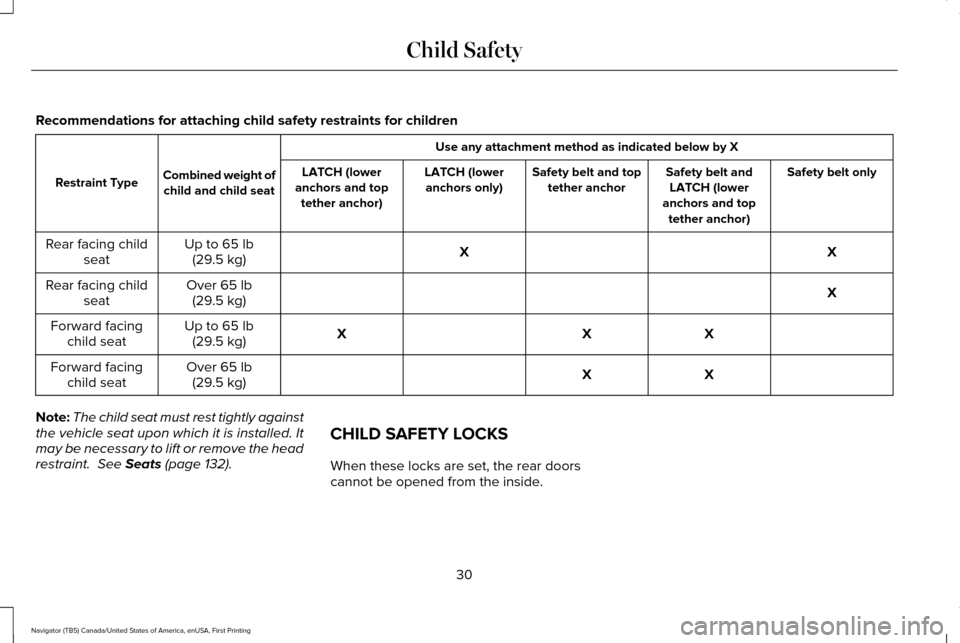
Recommendations for attaching child safety restraints for children
Use any attachment method as indicated below by X
Combined weight of child and child seat
Restraint Type Safety belt only
Safety belt and
LATCH (lower
anchors and top tether anchor)
Safety belt and top
tether anchor
LATCH (lower
anchors only)
LATCH (lower
anchors and top tether anchor)
X
X
Up to 65 lb
(29.5 kg)
Rear facing child
seat
X
Over
65 lb
(29.5 kg)
Rear facing child
seat
X
X
X
Up to
65 lb
(29.5 kg)
Forward facing
child seat
X
X
Over
65 lb
(29.5 kg)
Forward facing
child seat
Note: The child seat must rest tightly against
the vehicle seat upon which it is installed. It
may be necessary to lift or remove the head
restraint.
See Seats (page 132). CHILD SAFETY LOCKS
When these locks are set, the rear doors
cannot be opened from the inside.
30
Navigator (TB5) Canada/United States of America, enUSA, First Printing Child Safety
Page 34 of 419
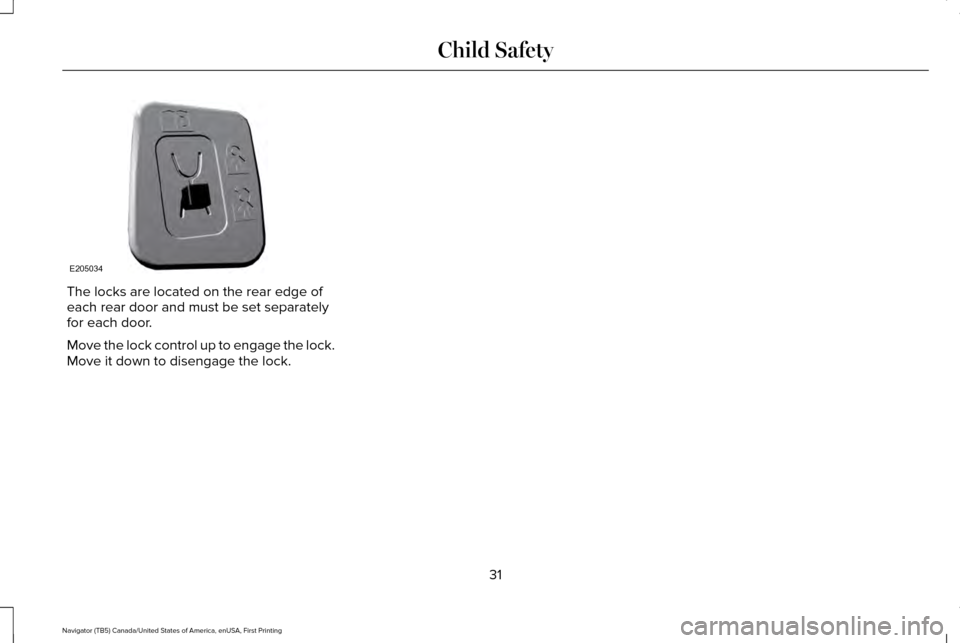
The locks are located on the rear edge of
each rear door and must be set separately
for each door.
Move the lock control up to engage the lock.
Move it down to disengage the lock.
31
Navigator (TB5) Canada/United States of America, enUSA, First Printing Child SafetyE205034
Page 35 of 419
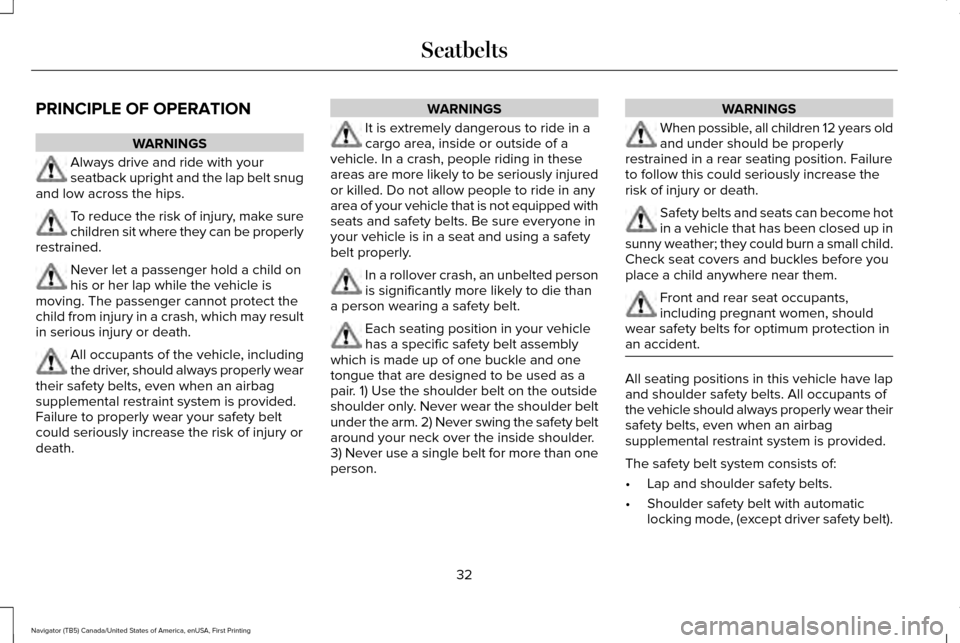
PRINCIPLE OF OPERATION
WARNINGS
Always drive and ride with your
seatback upright and the lap belt snug
and low across the hips. To reduce the risk of injury, make sure
children sit where they can be properly
restrained. Never let a passenger hold a child on
his or her lap while the vehicle is
moving. The passenger cannot protect the
child from injury in a crash, which may result
in serious injury or death. All occupants of the vehicle, including
the driver, should always properly wear
their safety belts, even when an airbag
supplemental restraint system is provided.
Failure to properly wear your safety belt
could seriously increase the risk of injury or
death. WARNINGS
It is extremely dangerous to ride in a
cargo area, inside or outside of a
vehicle. In a crash, people riding in these
areas are more likely to be seriously injured
or killed. Do not allow people to ride in any
area of your vehicle that is not equipped with
seats and safety belts. Be sure everyone in
your vehicle is in a seat and using a safety
belt properly. In a rollover crash, an unbelted person
is significantly more likely to die than
a person wearing a safety belt. Each seating position in your vehicle
has a specific safety belt assembly
which is made up of one buckle and one
tongue that are designed to be used as a
pair. 1) Use the shoulder belt on the outside
shoulder only. Never wear the shoulder belt
under the arm. 2) Never swing the safety belt
around your neck over the inside shoulder.
3) Never use a single belt for more than one
person. WARNINGS
When possible, all children 12 years old
and under should be properly
restrained in a rear seating position. Failure
to follow this could seriously increase the
risk of injury or death. Safety belts and seats can become hot
in a vehicle that has been closed up in
sunny weather; they could burn a small child.
Check seat covers and buckles before you
place a child anywhere near them. Front and rear seat occupants,
including pregnant women, should
wear safety belts for optimum protection in
an accident. All seating positions in this vehicle have lap
and shoulder safety belts. All occupants of
the vehicle should always properly wear their
safety belts, even when an airbag
supplemental restraint system is provided.
The safety belt system consists of:
•
Lap and shoulder safety belts.
• Shoulder safety belt with automatic
locking mode, (except driver safety belt).
32
Navigator (TB5) Canada/United States of America, enUSA, First Printing Seatbelts